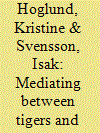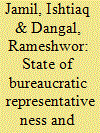|
|
|
Sort Order |
|
|
|
Items / Page
|
|
|
|
|
|
|
| Srl | Item |
| 1 |
ID:
088484


|
|
|
|
|
| Publication |
2009.
|
| Summary/Abstract |
The Naxalbari movement, a radical Maoist movement, marks a significant moment in the postcolonial history of West Bengal, as well as in the larger context of India. Beginning as an armed peasant movement in 1967 in the Naxalbari area of northern West Bengal, the movement soon was spread in different districts of West Bengal and several provinces of India. Even though it has been one of the well-studied political and social events in postcolonial West Bengal, the gender dimension, particularly the history of women's participation, remains neglected in the historiography of the movement. A critical review from the point of view of gender requires contextualisation of gender relations according to class, ethnicity, spatial locations, and cultural environments of men and women Naxalites. Through a discussion of the centrality of Calcutta - the metropolitan centre - in the dominant memory and history of Naxalbari, I argue that activists from mofussil or non-metropolitan backgrounds, especially non-metropolitan women, have remained marginally represented, in spite of their significant contribution. This essay re-reads the movement with new information and insight, gained principally through women's words
|
|
|
|
|
|
|
|
|
|
|
|
|
|
|
|
| 2 |
ID:
088487


|
|
|
|
|
| Publication |
2009.
|
| Summary/Abstract |
This research note describes the second stage of 'Fair Tracing', a research project funded by the Engineering and Physical Sciences Research Council of the United Kingdom. The project aims to support ethical trade by implementing digital tracing technologies in value chains to provide consumers and producers with enhanced information about specific products; in this case, Chilean wine and Indian coffee. The genesis and first stage of the project - as it relates to the India case study - was documented in an earlier research note published in Contemporary South Asia one year ago. This note goes on to describe the second stage of this case study, which begins by mapping the life of the coffee bean in its current global commodity chain, and ends with proposing a traceable value chain for small growers of Indian coffee. It is argued that the use of tracking technologies will help increase the value chain 'rents' that accrue to farmers in developing countries by allowing them to charge more for differentiated products increasingly demanded by informed consumers, both in the West and in home markets.
|
|
|
|
|
|
|
|
|
|
|
|
|
|
|
|
| 3 |
ID:
088483


|
|
|
|
|
| Publication |
2009.
|
| Summary/Abstract |
This article examines desired family size and sex composition, the extent of son preference, the underlying motivations for the preference, and the knowledge and use of the new reproductive technologies to achieve these preferences in two culturally distinct but economically similar immigrant communities in New Delhi, India. The two groups - one group from Punjab, north India, and the other from Kerala, south India - are considered in the literature to be two extremes in the socio-cultural spectrum, particularly in terms of kinship organizations, gender relations, women's decision-making power, and levels of women's autonomy. The results of the study suggest that shared urban experience, acceptance of a small family norm, and easy accessibility of new reproductive technologies and abortion services have led to similarities in desired family size, preference for sons, and means taken to realize their preference in the two communities. The article concludes with a discussion of the intricate and intersecting views of parents on family size, son preference and daughter neglect, and the many ways of regulating family size and sex composition in urban India, and draws parallel with similar research findings in India and elsewhere in Asia.
|
|
|
|
|
|
|
|
|
|
|
|
|
|
|
|
| 4 |
ID:
088482


|
|
|
|
|
| Publication |
2009.
|
| Summary/Abstract |
The ascendance of the multiplex film theatre in India has great significance in the creation of new public space, and is part and parcel of the long-running contestation of modernity and citizenship in postcolonial India. However, while the histories of urbanism, cinema and modern politics are usefully indicative of each other, their relationship in this instance also needs to be further related to the history of leisure capital in India and, in particular, to the contemporary dynamics of the media economy. The rise of the multiplex is closely related to the re-organisation of working practices and of capital investment within the film exhibition sector. The aggregation of interests within what has traditionally been a highly fragmented industry with largely informal organisation is a result of both the entry of outside concerns into the theatrical market and of operational change within the industry itself as leading players pursue an agenda of 'corporatisation'. It is these new corporate entities, funded by institutional investors and public flotation, that dominate the multiplex business, which has arisen in marked contrast to the loose agglomeration of family-owned theatres that have previously characterised theatrical exhibition in India. As the leading multiplex brands embark upon a massive programme of expansion into India's second-tier cities, this paper provides a critical account of the emerging political economy of the multiplex paradigm.
|
|
|
|
|
|
|
|
|
|
|
|
|
|
|
|
| 5 |
ID:
088485


|
|
|
|
|
| Publication |
2009.
|
| Summary/Abstract |
Sri Lanka has suffered from one of Asia's most intractable civil wars, and is remarkably resistant to resolution. The peace process was initiated with a ceasefire between the separatist Liberation Tigers of Tamil Eelam and the Sri Lankan Government in 2002. This article explores the implications of the Norwegian mediation on this process. We argue that Norway's aspiration to promote an image of being a global peacemaker and the consent from regional and global powers are important in explaining why Norway became involved. Moreover, the Norwegian mediation approach - based on impartiality, ownership by the two main parties, and internationalization - has had consequences for how the process has unfolded. For instance, it influenced the potential leverage of Norway and conceptions about bias. This article contributes to an understanding of how regional and global processes, as well as mediator characteristics and approaches, influence the dynamics of civil war termination.
|
|
|
|
|
|
|
|
|
|
|
|
|
|
|
|
| 6 |
ID:
088486


|
|
|
|
|
| Publication |
2009.
|
| Summary/Abstract |
The article compares the demographic composition of the Nepalese bureaucracy with the demographics of the general population, and, thereafter, maps the administrative culture in Nepal. With regard to administrative culture, it highlights, more specifically, the values and norms dominant among Nepali bureaucrats. In this regard, three relationships are focused upon: relationships among bureaucrats within the bureaucracy, the interface between the bureaucracy and politics, and the relationship between bureaucrats and citizens. Findings revealed that, in terms of demography, the bureaucracy in Nepal is gender biased, religion biased and caste biased, which means that the bureaucracy favors Hindu males who belong to the upper caste and come from an agricultural background. Therefore elitism, coupled with a rural background, has implications for the kinds of values and norms that evolve among Nepalese bureaucrats. From observations of its decision-making procedures and interpersonal relationships, both within and outside the bureaucracy, one may conclude that administrative culture is guided more by particularism than universalism, by ascription than achievement, by rule-orientation than result orientation, and by more authoritarian than participatory values. Most often, administrative decisions are taken on the basis of informal connections and close affinities than by formal and impersonal rules. Civil servants are often guided more by status orientation, ascription, hierarchy, and collective norms. These values are mere reflections of dominant societal culture based on caste and strict social stratification.
|
|
|
|
|
|
|
|
|
|
|
|
|
|
|
|
|
|
|
|
|